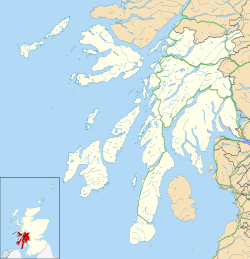Achnacroish
| |
|---|---|
 Pier at Achnacroish | |
Location within Argyll and Bute | |
| OS grid reference | NM851409 |
| Council area | |
| Lieutenancy area | |
| Country | Scotland |
| Sovereign state | United Kingdom |
| Post town | OBAN |
| Postcode district | PA34 |
| Police | Scotland |
| Fire | Scottish |
| Ambulance | Scottish |
| UK Parliament | |
| Scottish Parliament | |
Achnacroish (Scottish Gaelic : Achadh na Croise) is a hamlet on the Scottish island of Lismore. The harbour serves the ferry between Lismore and Oban. [1]
The hamlet has the island's primary school. A heritage centre and a church are within walking distance. The church is remarkable as it stands on the same spot as a cathedral that was the home of the Bishop of Argyll from the year 1200. [1]
